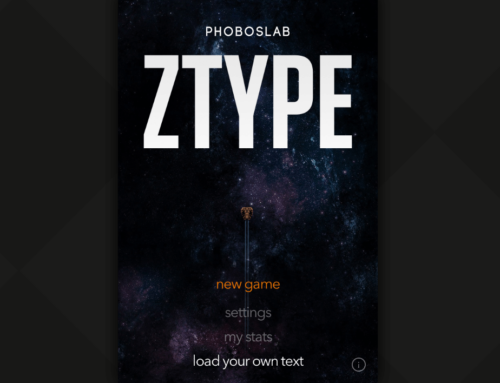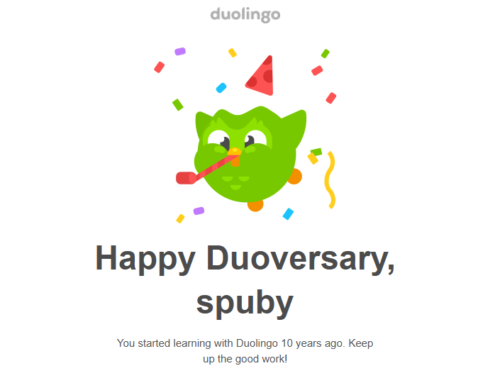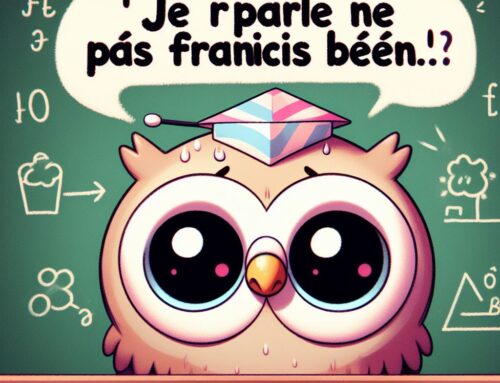Overview
“What we wanted was flying cars, what we got was 140 characters”. It is a quote by Peter Thiel (founder of PayPal) and one of my favorite ones. I like it because it sums up very well the contrast between our past expectations regarding the future and the reality of present. In this present social is the new hype, everything is social and on a fast pace. People are on Twitter, Facebook, Google+ or socially connected through one of the other gazillion services.
Social connections aren’t bad, the highly evolved part of our brain (neo-cortex) demands it to improve our chances of surviving (groups survive better than individuals). We’re having more social interactions in a day now than our ancestors in their whole lives. But there’s a downside of socializing too much too fast with too many people, especially from a smaller device such as a smartphone: bad grammar.
Teens (actually tweens) are now forced into cramming their thoughts in 140 characters or less when they want to use Twitter, send a text message or chat. If on Twitter that’s a technical limitation, for other means is just a habit inherited from previous times (SMS messages had a 160 character limit). Thus they are obligated to abbreviate words. ‘Thank you’ becomes ‘10Q’, ‘Oh my God’ becomes ‘OMG’, ‘Laughing out loud’ becomes ‘LOL’ and even ‘Love’ loses meaning when it’s written as ‘LUV’. They call this ‘techspeak’ and say they’re using it to write faster and group more thoughts in a single message. But the problem is that this type of communication will be transferred to their normal communication channel as well.
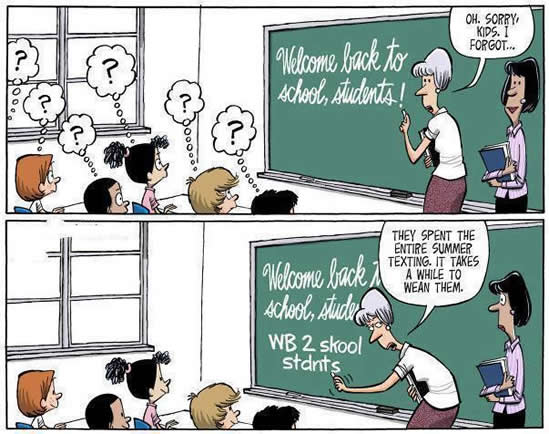
Sad but true with today’s generations.
“The relationship between text messaging and English grammar skills” is a recent paper that shows exactly the relation between texting/techspeak and bad grammar assessment results. The result of their survey shows that teens using this type of communication had their written grammar skills affected as well. Teens that have poor grammar skills will have lower chances of getting a good job and building a career that’s why it’s important to help them help themselves. Luckily there’s something you can do, as a parent, to help with their grammar: install Grammaropolis on their smarpthone.
Design and functionality
Grammaropolis is an award-winning educational app that helps kids learn grammar the fun way. Its name translates to ‘The town of grammar’ (‘polis’ in Greek means ‘city’) and if we delve more even the word grammar derives from a Greek compound noun which translates to ‘art of letters’ (surprisingly related to the word ‘glamour’). The ‘mayor’ of Grammaropolis is Coert Voorhees, a popular author who used his teaching experience and passion for grammar to create a platform that helps children learn grammar and educators teach better.
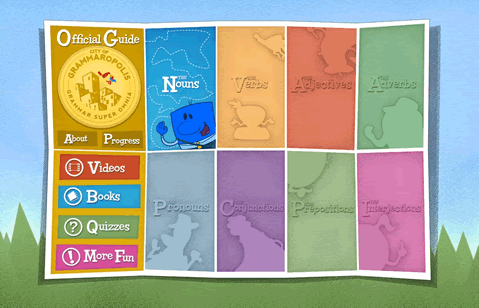
Main interface of Grammaropolis
Grammaropolis uses the elements of a speech as animated cartoon-like characters that sing songs, have adventures recorded in videos, star in books and play games. Grammaropolis combines game-based learning with traditional quizzes and the result is a package more attractive to kids than regular grammar books. Its educational learning principle has several key points:
- Improved learning. In comparison to formal learning methods, kids will learn better with games/interactive content because this is the ‘Low-Road’ of learning.
- Increased motivation. The fact that they play games, watch videos and listen to songs throughout the learning process keeps them motivated to continue. They’re children after all and it wasn’t long ago when all they did was playing, that’s why they relate better to this method.
- Positive attitude. Learning in a fun way helps building a positive attitude towards learning as a whole and grammar in particular.
- Independence. With Grammaropolis they will be able to work independent from their teacher. They feel motivated by the fun part to continue learning and the teacher is there to assist them if needed.
Since a picture is worth a thousand words, a video is priceless thus I did a short video presentation of Grammaropolis which you can watch below:
Grammaropolis is beautifully designed to be in line with their method of teaching. It seamlessly integrates video and audio, includes cartoon-like characters/surroundings and even the quizzes are fun. When it starts you get an overview of the 8 sections (neighborhoods) that are available, of which Nouns is included in the freemium edition, but for $10 you can get the other sections too: verbs, adjectives, adverbs, pronouns, conjunctions, prepositions and interjections.
Each of the speech neighborhoods has its own map (curriculum) with various checkpoints (9 areas). Each of those checkpoints teaches the user something about that part of the speech in a form of a video, illustrated book or song, at the end of which there will be a short quiz (3 questions). The quizzes are designed to strengthen the notions presented earlier. When the end of the map is reached, they will receive a badge to encourage them in trying the next section (or take this one again if there’s room for a higher score). Achievement-based learning at its best.
Here are the main features of Grammaropolis:
- Songs (music videos). The first educational song they released was called “Welcome to Grammaropolis” and it quickly became a Top 10 national hit on SiriusXM Radio’s Kids Place Live (this radio has over 25 million subscribers). The reason the song became popular is the fact that it is catchy. Listen to the ‘Noun Town’ below and tell me the song doesn’t resonate in your mind after you’ve finished listening to it:
[…]Noun Town
What’s that sound?
A person, place or thing is found in
Noun Town
So profound
Name ideas, mess around with
Who is that guy?
What is that thing?
What is that place?
I’ll name and you sing
‘Cause I’m a noun noun noun noun
Noun noun noun noun
Noun[…]These are the types of songs that will be presented in various areas of the Grammaropolis neighborhoods. Some are 30 seconds, others are longer, overall 21 songs that add up to 1 hour of fun with grammar.
- Videos. Every part of a speech has its list of videos that explain a notion. These are different from the musical ones as they’re presented in a more ‘serious’ note, by the same familiar cartoon-like speech characters. Your kids will interpret this as watching cartoons rather than being shown a grammar lesson, with the advantage that after watching it they will learn something. There are plenty of videos to watch, for an idea you can visit the official YouTube channel for Grammaropolis.
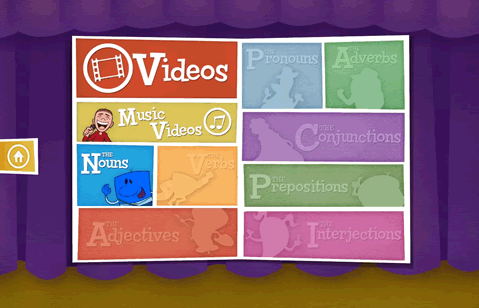
Video section in Grammaropolis
- Illustrated books. Each section has its own illustrated book so your kids will interpret those as their own comic books with speech characters. If you give them a classic grammar book they’ll feel the skies fell down on them with all those definitions and exercises. However by browsing the Grammaropolis ones they’ll get the happy feeling of browsing a comic book rather than a grammar one (even though at the end of it they’ll learn another lesson).
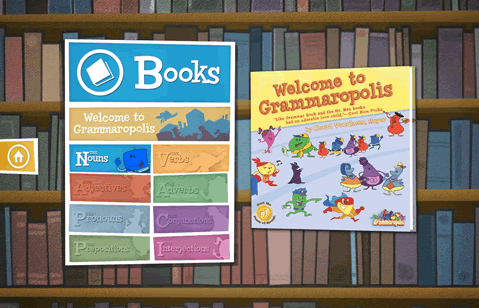
Illustrated books in Grammaropolis
- Quizzes. Having lived my first school years in a communist country I tend to value assignments more, as that was the classic way of learning. The difference is that back then I was ‘forcefully-taught’ and God-forbid any of us failed on an assignment (let’s just say beatings didn’t stop until morale was up). With Grammaropolis quizzes have few resemblances to classic assignments, the key difference being the part that they’re fun too. I don’t know if it’s because of the cartoon-ish letters, or because they highlight the key part, or maybe because of the video/book leading to this quiz, but kids will enjoy quizzes too. There’s the regular 3 question quizzes that are part of the neighborhood map, and then there’s the dedicated section of quizzes where you get the 10 question ones. Each part of the speech has its own list of quizzes so there’s enough to practice and keep practicing (the nouns section alone has 4 sections each with 5 quizzes and room for 5 more). Quizzes can be restarted if you didn’t like the score obtained, as that gets mentioned in the Progress section.
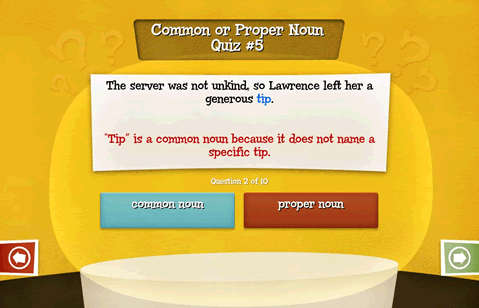
Quizzes can be fun too
- Progress. There’s an overall progress within the app that shows the overall quiz score, the town quiz score and the extra credit one. Aside that, you get a progress section for each of those 8 speech parts with detailed statistics on how well you did. You get to see how many areas from the neighborhood were visited, what was the percentage of correct quiz answers, how many quizzes you’ve taken (regular or extra-credit ones) and also statistics for each area. As an example, for the Noun section you see how many quizzes you took and what was the percentage of correct answers for these areas: “Common or proper”, “Abstract or Concrete”, “Collective or Compound”, “Singular or Plural”
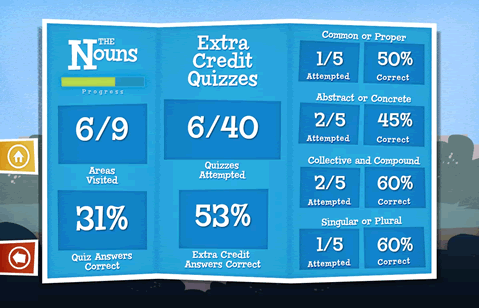
Progress through the Noun town
- Award-winning methodology. The teaching methods used in Grammaropolis were awarded and approved by important organizations. It received the “National Parenting Center’s 2012 Seal of Approval”, the “Parents’ Choice Approved Award” (2012) and also a NAPPA Silver Award (2012). These are all important awards that show the specialists’ opinions regarding the methodology used in Grammaropolis.
Conclusion
“Grammar super omnia” is the slogan of Grammaropolis and translates to ‘Grammar above all’, one that I approve with. I know it’s hard to convince kids of doing things these days, especially learning grammar, but you have an ally in Grammaropolis. Just install it on the tablet/smartphone your kid has access to and they’ll start it at least out of curiosity, given the cartoon-ish look of the app. Once they start listening the fun but educational videos, audios or browse the illustrated books, they’ll want more. It’s a small investment you can make for your child’s knowledge of grammar, one that will help them write (even speak) correctly. No more LOLs and BRBs, we want them to be the ones that invent the flying cars we’ll travel with to our pension resorts.
You can read more about Grammaropolis via their website and also download the app directly from Google Play: Download Grammaropolis.

Name: Grammaropolis
Developer: Grammaropolis LLC
Size: 38Mb
Package: com.Grammaropolis.Grammaropolis.apk
Version: 1.0
Last update: August 1, 2013
Price: Freemium

